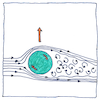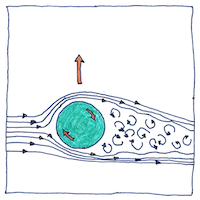Isaac Newton,
Benjamin Robins,
Heinrich Gustav Magnus
aerodynamics

|
Magnus effect
Considering then rejecting the idea that “Rays of light should possibly be globular bodies” to explain why a prism bends rays of light, Isaac Newton remembered seeing a tennis ball “struck with an oblique Racket,” describe a curve and explained why it turns in the air: “For, a circular as well as a progressive motion being communicated to it by that stroke, its parts on that side, where the motions conspire, must press and beat the contiguous Air more violently than on the other, and there excite a reluctancy and reaction of the Air proportionably greater.” * To show that a whirling motion of a bullet “deflects it from its course,” Benjamin Robins suspended a four-and-a-half-inch wooden ball from a long double string, twisted the string, and drew the ball away from the perpendicular. After he let it go, it whirled by the untwisting of the string and began to deviate from the vertical plane “and sometimes proceeded so far, as to have its direction at right angles to that, in which it began its motion; and this deviation was not produced by the action of the string itself, but appeared to be entirely owing to the resistance being greater on the one part of the leading surface of the globe than on the other.” * Guess who else studied the deflection of projectiles? The effect was named after him, and my main difficulty is that I have found his paper published only in German; however, my dogged attempt to translate it confirms that Gustav Magnus designed clever experiments to show that the effect results from a difference of pressure on opposite sides perpendicular to the direction of flight caused by rotation of a body while moving through the air.
Flettner rotor
Anton Flettner was not a mad scientist; that is, he was not mad. He invented the famous Flettner ventilator. He built the first schooner moved by the Magnus effect; two rotating cylinders propelled it across the Atlantic. He developed control devices for aircraft and boats in World War I. He designed helicopters in World War II. His wife was Jewish but the Germans escorted her and her family safely to Sweden. The Flettner airplane replaced wings with whirling cylinders and might still be the aircraft of the future.
Aft
Aft of the body, that is, opposite its direction of flight, the air produces a force on the body opposite to its spin. If in its wake it spins left, then it moves right. * An angular deflection in its turbulent tail in its direction of spin wants to move a body in the opposite direction of the deflection. * Since pressure is related to air speed and a spinning body moves the air around it, air flows faster where the spin is in the direction of movement and slower on the opposite side, causing a difference in pressure that moves the body from its high-pressure side to its low-pressure side.



Some sources say the effect is caused by the deflection of the wake, and others say it is caused by a difference in pressure perpendicular to the direction of flight.
If you could eliminate turbulence around a moving body, you would save a lot of energy. Turbulence at its tail slows a projectile more than the force of air at its head.
See also in The book of science:
Readings in wikipedia:
Other readings: